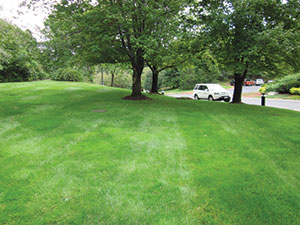Several lawn care pros using organic soil amendments say they’ll never go back to their old ways.
At a time when organic lawn care products are gaining buzz in the Green Industry, one product in particular is making a strong push in the market. And the lawn care professionals using it say they’re seeing results.

The product is called Holganix. It’s a 100-percent organic soil amendment that functions as a biostimulant, enabling plants to efficiently take up nutrients
and pesticides.
Some companies are hesitant to use Holganix, a type of compost tea, because it must be refrigerated in special refrigeration units at 33 to 44 degrees. But the vendor provides and sets up the units for clients at no cost. The units come in three sizes based on the amount of the product a company will need.
“I don’t see us going back to what we were doing before—not at all,” says Ed Fleming, owner of Milton, Del.-based Lawns Unlimited. Fleming made the switch from liquid fertilizers and micronutrient packages to Holganix two years ago, wanting to reduce the amount of nitrogen and herbicides applied to his customers’ lawns.
“The concern was the amount of nitrogen we applied,” he says. “We wanted the plant to not be dependent on it as much. The more fertilizers that we apply onto these lawns, the more we’re reducing the biology in the soil.”
Plant health elements
Fleming, who is an agronomist, learned about Holganix from one of his distributors. Since he’s been using it, he says he’s noted better color, fewer disease problems, healthier and stronger root systems and better control of broadleaf weeds on his customers’ lawns.
“Based on the depth of the roots and the thickness of the turf, our lawns just stand out compared to our competition. They’re greener, thicker and healthier,” he says. “And the program is cumulative, so the longer you use it, the better the results are.”
Gerry White, managing partner at Grassmaster Plus in Georgetown, Mass., north of Boston, has been using Holganix since last June. White had a 20-year career as a golf course superintendent before making his foray into lawn care six years ago. As a superintendent, he used organic products on fairways and greens to maintain the health of the soil.
When White saw Holganix, he thought it could help reduce his inputs, including the amount of nitrogen and pesticides his workers applied.
“The goal is to have a thicker lawn and fewer inputs of pesticides and herbicides,” White says. “I would say I’ve been able to cut my herbicides down, from a rate standpoint. I want to see it through another season, but I’m definitely intrigued by it and happy with the results I’ve seen so far”—results such as thicker blades of grass that grow laterally instead of vertically, he says.
Scott Whitehead, CEO of Unlimited Landscaping and Turf Management Inc. in Buford, Ga., is new to the Holganix program, launching it Jan. 1. It’s too early to see results, since the grass is just now coming out of dormancy, Whitehead says, but he’s optimistic.

Environmental consciousness
The environmental health benefits and fewer inputs of Holganix are most appealing to Whitehead. “We want to give customers exactly what their lawn needs and not more than that—to avoid having products just run off into our lakes, rivers, creeks and streams,” he says.
In years past, Unlimited was “fertilizing non-stop,” Whitehead says. But he got fed up with that. “We wanted to set ourselves apart and have a more organic approach than our competitors.”
Using less fertilizer also is vital for Fleming, who’s focused on environmental stewardship. “Using organics is important for being a good steward of the soil and the earth,” he says. Whereas slow-release fertilizers used to be on Fleming’s agenda, now he’s focused on “preserving the biology in the soil, so the soil can feed the health of the plant,” he says. “It’s kind of like either putting people on welfare or giving them a job so they can be dependent on themselves.”
Holganix can be more expensive than typical fertilizing products—White says it increased his material costs by about 5 percent. But “the benefits far outweigh the costs,” he says. “If you look at the whole picture, in the long run it will save money because you can reduce your rates, spend less time spraying on the property, all of those things are going to build up as time goes on.”
One year into it, White has Holganix on all his trucks. “I wanted to see it last year,” he says. “I wanted to believe it, and I saw good enough results where I made the switch completely. I’m all in, baby.”

